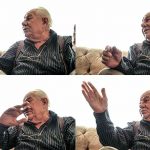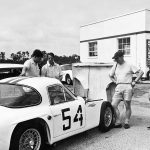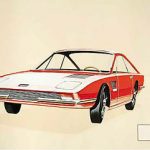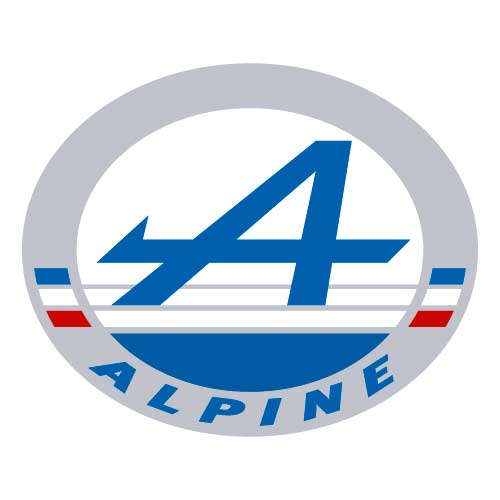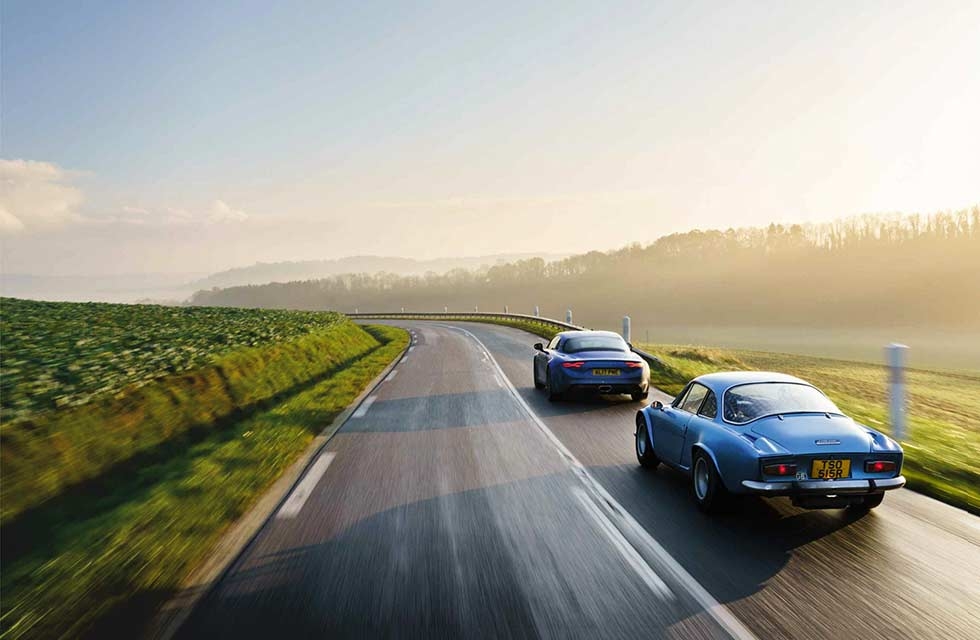
Homing missiles. Alpine A110: old and new. Back home to Dieppe in the hottest sports car of the moment – and the car that inspired it. The new 2018 Alpine A110 is the sports car of the moment, but can it live up to its forebear? We find out on a trip to Alpine’s Dieppe factory. Words John Simister. Photography Dean Smith.
ALPINES ON TOUR! TO DIEPPE IN OLD AND NEW A110
Modern versus retro. New versus old. Idea versus reality. Alpine A110 versus Alpine A110. Where does the memory end and the present begin?
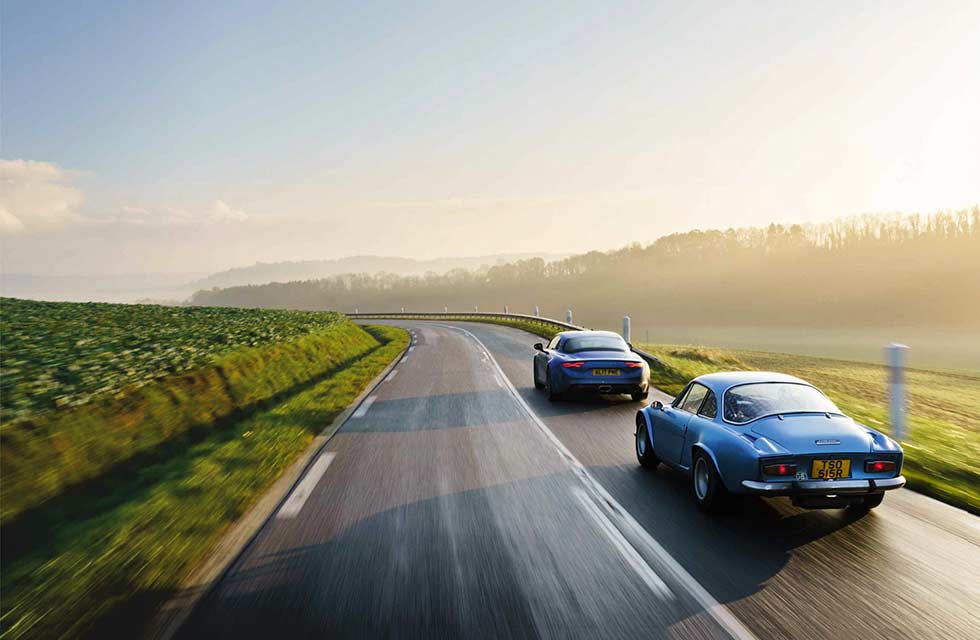
In my case, 4am on a damp Monday. I’ve already driven the new version of the A110, raved about by all who encounter it and performance Car of the Year at Drive-My’s Historic Motoring Awards. But, until now, I have not driven an original even though I have longed to for years. It’s a car that, for a British audience, has long lurked under the radar despite international fame as a multiple rally winner. It was never sold here, being left-hand drive and caught up with UK-specific naming trouble: Chrysler UK and its Rootes predecessor owned the Alpine name and applied it first to various Sunbeams, later to front-drive family hatchbacks.
‘I SWAP INTO THE NEW A110 AND ENTER A DIFFERENT WORLD. YOU WORK WITH THE OLD A110; THE NEW ONE WORKS FOR YOU’
Too bad for us that back then we couldn’t have this conceptual melange of Porsche and Lotus, this low, sleek, rounded and usually blue projectile from Dieppe, just a ferry-hop away from Britain. But I have one now, in my driveway, positioned so it won’t wake too many neighbours as I attempt to slink off into the darkness. It’s a bit tweaked over standard, with 140 or so bhp instead of the 93bhp normal in the final, 1600 SX version of the original A110 breed, and the megaphone tailpipe on the end of the minimal silencer makes sure everyone knows that fact.
It’s not actually mine, sad to say. this 1977 car belongs to Renault UK, which acquired it while the new A110 was still under development, the heritage people found it in Spain, where it had lived in the collection of a Spanish rally champion and been used for hillclimbs. That explains the rollcage, the exhaust, the hot camshaft and the pair of Weber 45 DCOEs. ‘We wanted one of the last French-built ones,’ says the heritage collection’s Steve Gault. ‘It was mechanically sound but we’ve done the paint.’ Indeed they have, and it’s beautiful, they have also replaced the tired rally-style seats with new ones, fixed directly to the floor to maximise the minimal headroom.
A110s were also, as Alpine aficionados are keenly aware, made in Spain, Mexico and Bulgaria – all places where Renault had overseas assembly operations and mechanical parts were therefore easily sourced. But the Dieppe-built ones are the most prized, and also the lightest although that was never the official intention. We’ll learn more about that later, along with how well Steve did in his quest for a late A110: it’s just 26 cars from the end.
So, my nocturnal escape, the Alpine and I are headed for the Channel Tunnel, where I will rendezvous with Matthew Hayward of this vicinity who will have arrived in a spanking new A110 – also in metallic blue, of course, as most of them are. Once in France, we’ll head down the coast road to Dieppe, taking both cars back to their birthplace and seeing how that birthplace has changed since I last visited, over a decade ago, when Alpine was building Renaultsport versions of regular Renaults.
On my visit before that it was the second generation of mid-engined Clio V6, and both times the aura was one of outsize tuning shop and low-volume specialist, the sweet smell of polyester resin hung in the air, as did the spirit of Alpine founder Jean Redele, and automation was non-existent. Now, I’m told, it’s a proper modern car factory. We’ll see.
Matthew and I will swap Alpines from time to time, comparing inspiration with execution, there will be common ground, of course. But how much?
I snort gently up my road, thankful for the familiar ability of twin-choke sidedraught Webers to carburate cleanly from cold. So there are no burps and splutters, no blips and throat-clearings to salvage imminent motive death. Out on the nearby bypass, as the engine warms I explore the deeper reaches of the accelerator travel while I acclimatise to the very snug surroundings.
This is a very compact car, low with a narrow cockpit. My left shoulder touches the lightweight door, my arms are angled towards the Berlinettes centre, my legs more so with my shins almost horizontal, as in a racing car. A hefty transverse hump shapes the floor between the seat and the pedals; below it is the backbone-tube chassis’ one steel crossmember. Side impact protection? Don’t even think about it, beyond speculating that this is at least a tougher body than an original Lotus Elan’s, these were rally cars, so they must be strong.
Foot down, the tail squats, the already light steering goes even lighter. On this damp road the Alpine’s natural thrust is a degree or two either side of straight-ahead, so keeping it absolutely true requires concentration. An old Porsche 911 is a paragon of directional plantedness in comparison to this; a lack of steering castor is why the Alpine is so darty, so hair-trigger.
And it’s certainly quick, as you’d expect when this eager motor has just 700kg to push. Below 3400rpm it’s a bit flat and surge-prone but it blares along happily enough, unless a hill intervenes. Above that speed the Webers cackle and blatter, the exhaust trumpets and every bit of throttle travel adds another spurt of energy, the 1647cc engine, first used in gentler guise in a Renault 16 TX, has an aluminium block and head, the lightness of which combination is comforting, given where the engine sits. It has racy hemispherical combustion chambers even though the valves are pushrod-operated, and will happily zip to 7000rpm. Maybe more, but I don’t dare.
Two outsize dials, their scales unusually starting at five o’clock, tell me between them that 113km/h, or our legal 70mph, neatly equates to 4000rpm in fifth gear. So I hover around that speed on the dark motorway, enjoying the light-spread of the four Cibies once I’ve worked out the logic of the lighting switches: a master switch atop the steering column, and a left stalk for side/dip/main. the right stalk, perversely in a left-hand-drive car, does the indicators, while a further stalk, projecting from the dashboard a hand’s width away, controls the wipers and washers: two speeds, nominally, but you’d need an accurate stopwatch to detect the difference.
Two tiny rear seats are behind me, the only spaces in the cabin able to accommodate a journey’s impedimenta because the front boot is almost completely full of spare wheel and plastic fuel tank, the roof pillars are slim and there’s a lot of glass, so snug doesn’t mean claustrophobic. And because I’m sitting so low, the road seems to rush past at a frantic rate. At first, 70mph feels like 100.
Just the Alpine A110 Berlinette and me, on a dark, murky night, Cibies carving a channel of visibility. In my mind I am variously Jean Ragnotti, Jean-Claude Andruet, Ove Andersson; Alpine aces all, masters of the unbalanced. I’vewantedtodothisforyears.
At the tunnel terminal the Alpines, parked together, look clearly related but there’s one immediate mismatch: scale, the new makes the old appear tiny. Deliciously delicate, too, with its greater glass-to-body ratio, its flowing curves, its tapering tail, the flat-topped, flared-out rear arches that are such a distinctive design feature.
Today’s Renault company was wise not to ape the original too literally, instead giving the new A110 uniformly round arches snugly framing hefty wheels. But look at the fat 13in wheels of the Berlinette: simple deep-set dishes of aluminium, a radial slot between each of the four wheelnuts in the Alpine style made famous in the UK by the three-nut, three-slot wheels of the Renault 5 Gordini – or Renault 5 Alpine as it was known everywhere else. Fat, squat and fabulous. Why would you want cartwheels with rubber bands when you could have these?
I had, though, expected a lot of rear negative camber. Most hot Berlinettes have it, the result of the Renault 8-based swing-axle rear suspension, the need to keep the centre of gravity low and a desire to avoid the dreaded tuck-under, the last ones, however, had double-wishbone rear suspension like that of the subsequent A310 (and indeed the new A110). Anticipating the drive to come, I can breathe a sigh of relief.
Both eras of A110 have the early-Alpine signatures of a rounded, four-light nose fluted up the centre, and the recesses in the flanks that are vestiges of a rear-engined Renault Dauphines air intakes rendered redundant because both admit cooling air to front-mounted radiators, the new A110 has two of these, one on each side, one for engine cooling, the other for the turbocharger’s water-cooled intercooler, the old one adds air scoops on its rear wings to channel air into the engine bay to feed the gasping Webers.
And then there are the gaps. Giant panel gaps between the Berlinettes glassfibre sections, millimetric precison in the snug fit of the new car’s aluminium skin. Here is encapsulated the philosophy difference between two. One is a tiny but airy rallying machine, handbuilt of glassfibre-clad tubes with minimal capital investment, a car that forces the human within to bend to its form and its will, the other is a paean to precision, formed of a computer- designed aluminium unibody, built around the human, comfortable, usable, claustrophobic. Should maximum pleasure include an element of pain?
In France, open single-carriageway roads now carry an 80km/h (50mph) limit and nearly everyone sticks to it. It’s sad and frustrating, the Berlinette feels like a caged beast, but it’s a good chance to refine the gearchange technique, the only spring-resistance is into the fifth/reverse plane, and accurate, deliberate aim is essential to cancel the vagaries of the loose linkage.
Soon I swap into the new A110 and enter a different, futuristic world, here’s width, space and an engine of digital precision in its smoothness and almost lag-free turbocharged response. Power here is 252bhp, delivered in a body-compressing surge barely interrupted by upshifts through the seven-speed, double-clutch transmission. You can’t have a new A110 with three pedals and a gearlever, which on one level seems an error. But when a DCT is as quick and intelligent as this, whether paddle-triggered or left to its own AI judgment, you have to silence the inner
Luddite and enjoy the different sort of intimacy that comes from total readiness for every dynamic demand. You work with the old A110; the new one works for you.
But the view aft, over the transverse, mid-mounted engine’s domain, is no more than a slit and the over-the- shoulder vista is practically non-existent. Nor is there any cabin storage, the rear ‘seat’ space now occupied by engine.
You do get front and rear boots, though; the greater size has its advantages.
We arrive in Dieppe, our only en-route glitch a broken alternator feed terminal in the Berlinette and consequent dead electrics. Steve fixes this mostly by feel, because the alternator is invisible from the engine bay. It’s driven from the bulkhead-adjacent end of the camshaft by two-stage belts, and visible through the rear window once a cover is removed in the cabin. So directions are needed from outside: ‘Left a bit, now up… that’s it.’ And repeat…
Next morning we run the gauntlet of yellow-jacketed protesters but they seem to like the duo of UK-registered A110s. Alpine affection clearly runs deep. We’re leaving the town in search of proper, open, sinuous and traffic-free roads so we can get properly under these cars’ metallic blue skins. Soon we reach a near-deserted road with a strong sense of the forest stage about it. the Berlinette snorts through the curves, steering garrulous, tail mostly planted on the damp surface except when I dither over a bend’s apex and back off, provoking an admonitory twitch aft.
This is one talkative car. You sense how the tail calls the shots, how the throttle is as much of a guidance system as the steering wheel, how the expected initial understeer never really happens. And because you always know what’s happening, the Berlinette is never scary. I hadn’t expected that. No wonder the rally drivers loved them.
‘RENAULT WAS WISE NOT TO APE THE ORIGINAL TOO LITERALLY, INSTEAD GIVING THE NEW A110 UNIFORMLY ROUND ARGHES SNUGLY FRAMING HEFTY WHEELS’
The new A110 is quite different. Faster, of course, savagely so, but for all its precision the steering has little true feel, just a synthesised weight that varies little. Nor are you aware of pendulous weight aft; when you turn at speed, the new car always seems to pivot about you, the driver, rather than about an axis that moves further forward the harder you drive. Low polar moment, and all that.
So the new A110 gobbles the bends with fantastic grip and efficiency, exhaust popping and banging theatrically if the (unnecessary) Sport mode is selected, while also riding the bumps with surprising and welcome suppleness just as the Berlinette does. It has taken a road like this to understand what the new car can do, to feel the thrill that comes from the forces it generates and the ease of metering them. It’s a millennial sort of thrill; the Berlinettes excitement, by contrast, is rooted in the 1960s.
Lunchtime. We’re back in Dieppe, at the casino once frequented by Jean Redele himself, and we’re meeting Jean-Pierre Limondin. He arrives in his own A110 1600 SX: unusual metallic green, standard spec and the last A110 built (chassis 11387). Renault UK’s car is just 26 units earlier. His is original, paint included, and J-P bought it new when he was an Alpine engineer, driving it off the line. He sold it two years on, to a man who was going to use it in competition until friends said not to on account of its historical significance, so the A110 sat pampered and inactive for decades, then J-P bought it back. ‘I paid more in euros than I had in francs the first time,’ he says ruefully.
It wears Alfa Giulia GT tail-lights: Alpine ran out of Renault 8 items just before A110 production ended after 16 years.
Jean-Pierre joined Alpine two years into that production, in December 1963. He was 24, liked Alpines and knocked on the door. His first job was to organise how to build Alpines overseas: ‘Jean Redele was trying to develop Mexico, so, after a quick probation, I went there for six months. I was still single, but I came back married.’
‘WE’LL HEAD DOWN THE GOAST ROAD TO DIEPPE, TAKING BOTH GARS BAGK TO THEIR BIRTHPLAGE, TO SEE HOW IT’S GHANGED’
But why Bulgaria – another example – of all places? ‘Jean Redele quickly realised it was possible to have production outside Dieppe – which couldn’t cope with demand – without investment as long as there was a Renault presence.
He sold the know-how to the local company that was building Renaults. In 1968 the Bulgarian population was very poor and the country needed dollars, so Alpines were made for export. Very few though, no more than 100.’
And the glassfibre thickness thing? ‘the specifications were all the same, and the cars were supposed to be the same. But in Dieppe, we made them as light as possible because they were wanted for racing.’ It was, it seems, a case of do as I say, not as I do.
‘Alpine was very small at the beginning. In 1968 Redele signed an agreement with Renault’s commercial director, Philippe Lamerrault, which gave Alpine access to every Renault dealer. Some did it well, some not. The factory was still a workshop, so a new factory was built in 1969. Redele invested a lot in this factory, and in a new model, the A310, which was more complex, that’s when Renault started to build its stake, which gradually grew to 100%.
‘Redele was losing control. Alpine had been very small, with a family spirit, the rally drivers were all very young when they joined the team, and we knew them all. They became famous because of Alpine and that sense of goodwill is still there today.’
And Redele himself, what was he like? ‘He was a charismatic man, with an easy authority. He would never demand, but you would somehow consider yourself obliged to do as he asked. He was approachable yet kept a distance: I would be Jean-Pierre but he was Monsieur Redele. He was 15 years older than me, but a handsome man and the girls liked him. He never missed a chance with them, and lived well.
‘When we were at Le Mans, he insisted that we all stay in the same hotel and ate at the same restaurant. It was that family spirit. Knowing that Renault had installed good managers, he left Alpine in 1975.’
Jean-Pierre himself left Renault in 1999, his later years spent in BEREX, the Bureau Etude et Recherche Exploratoire (a ‘think tank’ for Alpine and Renaultsport), and finally Renault itself. Now he has ordered a new A110, in metallic Gris Tonerre. Carlos Tavares himself, in charge of Renault during the new A110s gestation, engaged Jean-Pierre to sit on an advisory board for its esprit, to make it ‘a daughter of the original A110 but better’. And he loves the paddleshift gearbox: ‘So quick, so easy.’
We arrive at the factory as the rain starts again. It’s new-looking (two blocks for the new A110), squeaky-clean and nothing like I remember, the A110 structures are glued and riveted off-line by robots, then dressed with outer panels by humans, they are sent to Le Havre for a cataphoretic coating, then returned for assembly on a line by blue-clad Alpine workers, into complete A110s. The majority are metallic blue, but new colours are creeping in.
Alpine logos abound, and there’s not a Renault reference to be seen. As it shouts on the factory wall (in English), ‘Alpine Is Back!’ Yes, it’s 23 years since the last one, the A610, ceased production. But as far as the factory and the spirit are concerned, Alpine never actually went away.
‘THE RALLY DRIVERS WERE ALL YOUNG. THEY BEGAME FAMOUS BEGAUSE OF ALPINE AND THAT GOODWILL IS STILL THERE’ J-P LIMONDIN
TECHNICAL DATA FILE SPECIFICATIONS 2018 Alpine A110
Engine 1798cc DOHC 16V four-cylinder, transversely mid-mounted, aluminium block and head, turbocharged, electronic fuel injection and management
Max Power 252bhp @ 6000rpm / DIN nett
Max Torque 236lb ft @ 2000-5000rpm / DIN nett
Transmission Seven-speed robotised double-clutch, rear-wheel drive
Steering Rack and pinion, electrically assisted
Suspension Front and rear: double wishbones, coil springs, telescopic dampers, anti-roll bar
Brakes Vented discs
Weight 1100kg
Top speed 155mph
0-60mph 4.5sec
TECHNICAL DATA FILE SPECIFICATIONS 1977 Alpine A110 1600 SX Berlinette (standard spec)
Engine 1647cc OHV four-cylinder, rear-mounted, aluminium block and head, Weber 32 DAR twin-choke downdraught carburettor
Max Power 93bhp @ 6000rpm / DIN nett
Max Torque 94lb ft @ 3000rpm / DIN nett
Transmission Five-speed manual transaxle, rear-wheel drive
Steering Rack and pinion
Suspension Front and rear: double wishbones, coil springs, telescopic dampers, anti-roll bar
Brakes Discs
Weight 790kg
Top speed 121mph
0-60mph 9.5sec
Above and facing page: Difference in scale between the new and the old is clearly illustrated here; baby Berlinette was agile enough to be the very first WRC champ; room for driver and little else within. Right and facing page: Destination Dieppe, home of Alpine, via the Channel Tunnel – but who needs a map when the new car has sat-nav… Facing page, above and below: John Simister meets former Alpine engineer Jean-Pierre Limondin; at the historic Alpine factory in Dieppe: old site, new buildings, automated production lines; Limondin with his own Berlinette – the last ever built.

